All over our area there is evidence of human habitation going back almost 5000 years.Scattered across our hills and valleys are monuments of the pre-Christian era.There are “Ring Forts”, “Souterrains,” “Fulacht Fiadhs”, “Cromlechs”, “Stone Circles”, and “Galláin” in abundance.Most of these monuments were built during the Neolithic Age(New Stone Age) about 3,500 years B.C. and during the Bronze Age which began 2,000 years B.C.
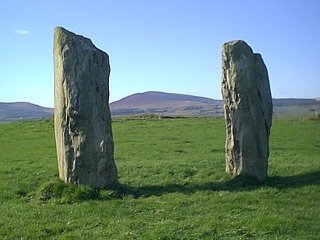 |
This stone pair is in the townland of Caherbaroule. We are not too sure what they were used for, but they were probably a ritual or a ceremonial site like a stone circle. These gallain are almost 3m in height. We know from research that there was a third one, but it has disappeared. |
Initially there may have been hunter-gatherers but eventually learned the skill of agriculture and established permanent settlements.They lived in houses built of wooden frames thatched with long grass and rushes. A group of these would have been protected by a ring fort. They worshiped the sun at stone circles and stone alignments. They buried their dead under cromlechs, dolmens, galláin and Ogham stones. They had a unique system of cooking deer, boar, etc. in Fulacht Fiaidhs. The evidence of our ancestors early existence is preserved for us by the existence of these ancient monuments in our locality.
| This cromlech is in the townland of Kilberrihert. The field it is in is known locally as Páirc na Lice (The field of the stone). Local folklore holds that a great hero was buried here. It is a rectangular gallery made of upright standing stones and is approximately 5m in lenght and 1.5m wide. | 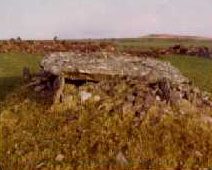 |
The Celts invaded Ireland and most definitely Rusheen around 600 B.C. This is obvious from the amount of forts found in the area. Perhaps the most remarkable of these is the two ringed fort found in Cahirbaroule.
They sometimes dug underground caves in their forts and used them as hidingplaces in times of trouble. There are a large number of these “Souterrains” scattered around the Rusheen area, expecially in Kilberrihert, Delish and Cahirbaroule.
 |
This ringfort is to be found in Caherbaroule. It is mainly made of stone. Ringforts were enclosed farmsteads built in the late Bronze Age. The circular ditch acted as a defence against all sorts of attackers. |
Sometimes the Celts lives in a Crannóg. This was rather like a fort except that it was situated on a lake. Around the Crannóg was a wooden pallisade or fence. Within the Crannóg were a number of circular buildings. The walls were made of timber stakes intertwined with branches or flexible twigs and plastered with mud or daub. The roofs were usually tatched. The advantage the Crannóg offered the inhabitants was that any attacker had to either come by boat, cross the guarded timber bridge or cross the zig zag stepping stones.
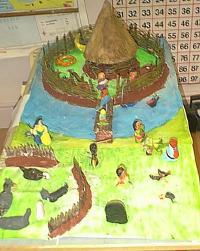
Here is a model of a Crannóg we made in school
The Celts had a unique system of cooking their food in what are known as “Fulacht Fiadhs”. They heated stones in a fire and when they were very hot, dropped them into a trough of water until it came to the boil and cooked the meat. Many of these are to be found around the area also.
| The Celts used a system of writing on stones called “Ogham”. The writing was chiselled onto the stones, beginning at the bottom. These stones usually commemorated the passing of a great chieftain. One such stone was found in Delish in 1986 and is now in the British Museum in London. The inscription on it is “Colabot Maqi Maqi – Rite Maqu Mucoi Coribiri” Here is a drawing we made of an “Ogham” stone with the word Rusheen inscribed on it. They wrote from the botom to the top of the stone. | 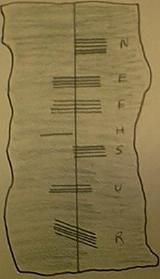 |
St. Patrick came to Ireland in 432 & converted the pagan Irish to Christianity. After him came many great Saints such as St. Brigid, St. Colmcille etc.
Saint Berrihert is the best known early saint in The Rusheen area. The townland of Kilberrihert ( Cill Berchert in Irish ) means church of Berrihert & the circular enclosure marked Cilleen in O.S. maps is probably where this church was. What remains of the site is shown in the photo above.
It is recorded in The Annals of the 4 Masters that he died in 893 A.D. His feast day is the 18th of February.
Tadge Beretchert was born in Winchester, the ancient capital of England and as young monk left Northumberland and came to Ireland.
He first built a Monastery in Tullylease , he later moved to nearby Freemount , and built another church , before coming to the present parish of Aghinagh.
Tadge Beretchert is reputed to have had red hair and before long he was nicknamed Tadge Dearg Beretchert. Tradition tells us that he had connections with the Red Well, hence the name Tobar Dearg.
| Further evidence of early Christanity exists in the townland of Caherbaroule. Here stands a small upright stone slab, with a greek (Christian) cross inscribed on it. Historians tell us that it dates from about 5OOAD. This must be the earliest reference to Christianity in Aghinagh. There is some evidence to suggest that the large Ringfort nearby may in fact be an early Monastic Settlement. |
 |
In the 8th century the Vikings invaded Ireland. In Aginagh there was an episode which had far-reaching consequences for Ireland. Brian Boru’s brother – Mahon – was on the run from the Danish king of Limerick and a chieftain named Molloy. As he fled from the Mallow direction through Knockrour, he was overtaken by the enemy and also by his rescuers, at Lahern, in Aghinagh parish. At this point, Colum, the Cleric tried to save the life of Mahon. It was to no avail and Mahon was murdered. Consequently, Brian Boru challenged Molloy – who was King of Munster – to a battle near Macroom, at the point where the Láine – a river that flows through Aghinagh -and the Sullane meet. The battle lasted from dawn to dusk – the fiercest ever fought in Muskerry. Brian’s son Murrough, a mere teenager, engaged Molloy hand in hand and slew the murderer of his uncle. Thus, at Macroom, in 987 – because of Molloy’s failure to show mercy at Laharn – the Danes of Munster were overcome and Brian Boru became King of the Province. This was the Munster final between the Irish and the Danes and it led to the All-Ireland contest between them and the ultimate conquest of the foreigners at Clontarf in 1014.

This is the stone at Bealick that marks the site of the battle
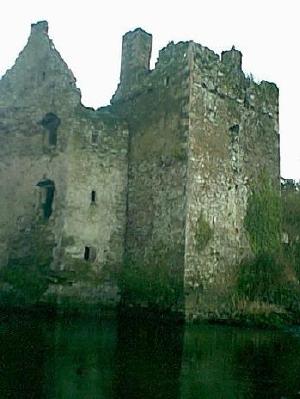 |
Carrigadrohid Castle stands on a rock in the middle of the river Lee.It was built by the famous princely Mc Carthys of Muskerry,who were at one time Kings of Munster and later lords of the barony. In the 15th century the castle was fortified by Cormac Mc Carthy and his wife Sabina Carrrol. A century later Cormac Mac Teigh and his wife Joan Butler, held and lived in the fortress but in 1583 he died suddenly leaving Joan in possesion of the castle. |
Beotius Mac Egan was born in Dunhallow and went to Spain at a fairly early age to complete his education. He returned to Ireland and became Bishop of Ross. Carrigadrohid castle was garrisoned by Irish troops and when Broghill, with Cromwell’s army, was on the march to Macroom, he was eager to come to grips with Roche’s army,and bypassed the the castle at Carrigadrohid. He captured Bishop Mac Egan at Macroom and told him that if he got the garrison to surrender he would spare his life. He sent one of his lieutenants to tell the garrison to surrender or he would hang the Bishop. He then brought the Bishop to Carrigadrohid but the Bishop told the garrison not to surrender, but to hold out to the last. The Bishop was then seized by the soldiers and hung by the reins of his own horse from a wild pear tree in front of the castle.
In the 16th century the McCarthy were lords of Muskerry (which included Aghinagh). Up to the Spring of 1580 – the year of the Mullinhassig battle – the lands of Muskerry belonged to the whole tribe of McCarthy and not to any one individual. But Cormac McTeige McCarthy, who was lord of Muskerry at this time, discovered that if he surrendered the land to the Queen, she would regrant them to him personally, and not to the clan. On the other hand, the Fitzgeralds, at this time had formed the Desmond confederation to fight for the Irish cause. To put it mildly, they had different politic to the McCarthys of Muskerry, who were “men of the crown”. It was common in those days – when clans were on bad terms – to make raids into the enemy territory and to carry off cattle. James Fitzgerald was on one such expedition to Muskerry, when he was confronted by “Donall of the county” McCarthy at Mullinhassig, in the parish of Aghinagh on the 4 August, 1580. Donall completely defeated James with a loss of 79 men (another source gives 150 slain). “A dart that struck him under the right ear and penetrated six inches into his neck” killed Donall himself. Sir James Fitzgerald, also, was very badly injured. The ancient historian Smith, says that he was captured, by a Blacksmith and, when the fighting ended, he was handed over to McCarthys men. “Sir James Fitzgerald – a true Irishman – is the knight in whose memory the ford at Mullinhassig is named – Athariddera – the Ford of the Knight.

This is Mullinhassig Waterfall near where the Battle was fought
The Penal Laws were enforced in Ireland at the end of the 1700’s in an effort by the minority Protstant population to protect their interests in Ireland. The Penal Laws were not vigorously enforced after the 1730’s. Nevertheless, they left a bad memory in Catholics minds and were used as propaganda in future years.These laws were directed against Catholic ownership of land and were an effort to deminish Catholic influence in Ireland. In the 18th Century, Land ownership meant power. Catholics were also forbidden to practice law, to hold public office or to bear arms. Neither could a Catholic own a horse worth more than £5. The following event from our area tells how this law about ownership of horses was put into force with tragic consquences.

This is “Morris’ Bridge, called after Abraham Morris, the villain of the following story
Arthur O’ Leary of Raleigh, Co. Cork, was born in the year 1747 and descended from the O’Learys Lord of Iveleary. Being of Roman Catholic faith he was not permitted to hold a job in the crown forces and therefore he left for the continent and entered the Hungarian services. On his return to Ireland a few years later he married Eilee Dubh Ni Conell and resided at Raleigh House near Macroom. Abraham Morris lived at Hanover Hall which is only two miles from Rusheen and took special pride in his stud of fine horses, on which he spared no expense. One of Morris’s supporters reminded him that the law forbade O’ Leary or any of his faith to own a horse exceeding £5 in value. Morris publicly claimed Arts horse. O’ Leary blatantly refused to surrender the horse and mounting the steed he rode away. Soon afterward a party of military was sent to his mansion. They encountered him riding along the road well armed. Shots were exchanged and Arthur “The Outlaw” was pierced by a bullet through the brain and died instantly on the road adjoining his house. Soon after a brother of Arthur’s set out to revenge his death. He made an attempt at killing Morris in Cork City with a pistol but did not kill him. Most of the victims of this cruel law have been simply forgotten, but Art’s story has been remembered because his wife wrote a poem in his memory called Caoineadh airt Ui Laoighre. The great sadness, for her, was that he died without a priest to say a prayer for his soul. Here is an extract from her poem, translated into english:
I found you before me dead Without pope, without bishop, Without monk, without priest, To say a psalm over you.
The earliest available record of Aghina appears to be 1451 A.D. when it was spelt “ACHYNACH”. The P.P. at that time was Lactinue O’Longach (1451-1457). One of the oldest records of the lands of Aghina is the “Civil Survey 1654”. It’s description of Aghina is as follows, “AGHINA – For the generality of the soyle it is cold and far from manure improper for much tillage expect for some few parcels near the river Lee”. The parish at that time had a very large population and the best and most arable of the land was held by the Gentry. These people owned large tracks of land and lived in big houses. Some of them were absentee landlords. They owned large farms in the area but didn’t live there. However, some of these landlords did live in the area and the following piece tells us about three of these big houses.
| Leades House is over 200 years old. It has a long history of owners. Colin Wolfe the present owner inherited it from his father Henry Wolfe. Henry Wolfe previously bought it from Peter Conolly. Peter’s father Dr. John Conolly served in the British army, and had inherited it from his uncle Major Woodley who served in the Boer War and the first Great War. He retired in 1920. Major Woodley also succeeded in the reprieve of 2 men involved in the Dripsey Ambush. Before him was Captain Woodley. The contents of the house were sold by public auction in 1981. |
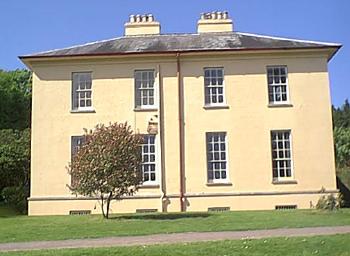 Leades House |
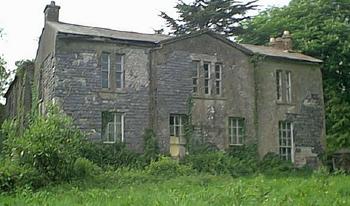 Kilberrihert House |
Killberrihert House was situated north of Cooperville and south east of Rockville. In its heyday it was the residence of Thomas Broderick. There were ornamental gardens and offices adjoining it. It is now owned by Mr John O’ Leary but the house is in bad repair. |
| Rockville is situated in the townland of Killberrihert and it is north west of Killberrihert House.It was the residence of Capt. Thomas Radley. It has ornamental gardens and is presently owned by Mr Pat and Claire Quill. |
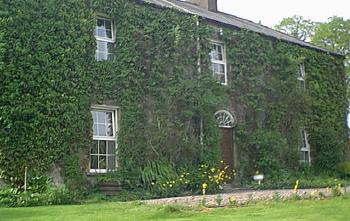 Rockville House |
Pupils from 3rd to 6th classes in Rusheen N.S. did a project about the Famine in Rusheen in they’re area. We studied how many people died or had to go to workhouses during the Famine and we also found out the increase or decrease in population in each of our townlands. We researched:
On this page you will find a summary of our book.
| This is the famine monument erected by the Aghinagh Heritage Group to commemorate The Great Famine. The plaque reads: “This monument which stands close to the site of a famine soup house is in rememberance of all those who died in the great famine 1845-1847, unveiled by Fr. Philip O’Keeffe P.P. 14th December, 1997”. | 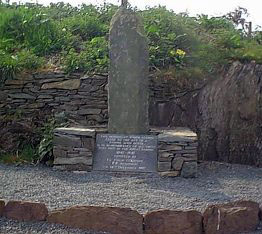 |
In 1845 some of the present parish of Aghinagh was in Aghbulogue. The 1845 parish of Aghinagh was a 4 x 5 mile rectangle. There were about 440 houses in 1841 and it had a population of 2,699.There were about 120 Protestants in the parish, a very high number. Most of the land was considered good land, only 800/9420 acres was considered wasteland. Landowners , according to Griffiths Valuation 1850 were Daniel Cokely, WilliamWhiteHedges of Macroom Castle, Woodleys of Leades, Richard Lloyd, Rev. James Gollock ,Rev. Pyne ,Steven Copinger , Thomas Croke and Gumbleton. It also lists Aghinagh as having a church and Ballyvongane N.S. , Carragadrohid with a Church of England school; Caum with a Catholic chapel and graveyard,; and Coolalta with a Church of England school and teacher’s dwelling. Aghinagh’s Parish Priest during ‘The Great Famine’ was Rev. Denis O’ Kearney who lived at Leades Cottage. There were many big houses in this area. Francis Woodley was landlord in Leades , Warsop Cooper in Cooper’s Ville , Fuller Harnett in Deelish , Croke in Killbehert and Radley in Rockville. Aghinagh was part of Macroom Poor Law Union , established in 1838. Aghinagh , as it was during the Famine , suffered less then some other parishes , since it had better land conditions. Aghinagh owned £639 in Rates for Poor Law Relief in 1848. In 1841 the population of the townlands we surveyed around Rusheen was 1159. In 1851 the population was 867 , which means that 352 either died or emigrated during the Famine. The % drop in population in our area was approximately 30%.
Fr. Denis O’ Kearney was the parish priest of Aghinagh at the time of the Famine. Here is a little piece about Fr. O’ Kearney. He did trojan work for his parishioners during the famine. There is a plaque on the wall in Ballinamorrive Church as he is buried near the Alter. Fr. O’ Kearney was born in Rockmills, Kildollery. Fr. O’ Kearney was appointed parish priest of Aghinagh in 1837,and remained here until his death from famine fever in 1848.

This is Richard and Mary Cotters house in Leades where Fr. Kearney lived
Fr. O’Kearney was a Parish Priest in Aghinagh During the Famine. He wrote numerous letters to the editor of the Cork Examiner. This is an extract from a letter on November 18th, 1846:
My dear sir, We have no time to breathe or at all attend to our usual occupations in this neighbourhood so great is the pressure upon us in consequence of the deplorable state of the poor people. Mr. John O’Connell as many more and I myself have for the last fortnight ten hands beyond my usual number. Several others have acted similarly. I am glad to tell you the comfortable farmers in this parish are behaving nobly. Their subscriptions are in amount far beyond their means. I expect a great deal from the resident and would I could say from the non-resident gentry. My neighbour. Mr. Hernett of Dellish has kindly sent me ten pounds, his second subscription.
Sincerely, my dear Sir. Denis O’Kearney, P.P.
For our famine project we wrote some poems on the famine.
This one was written by Abby:
The Year was 1845,
When the people got the worst fright of their lives,
The potatoes were all rotten and bad,
Which left the people feeling awfully sad.
Many people had to emigrate,
But this wasn’t the worst of fates,
Some of the people that stayed home,
Were so skinny you could feel their very bones,
Lord help us not to forget,
About the famines that are still here yet.
This poem was written by Sinéad:
Blight came across the sea,
People had to run or flee,
Or to the work house they would go,
Or walk the road to and fro.
Mothers screamed, babies cried,
Children wailed, Fathers tried,
No house to brush or sweep,
People die, others weep.
This one was written by Máire:
It was a gloomy day in 1845
The potatoes were planted the people were alive,
The days were windy with a fungus in the air
In the August of 1845 at first light,
Farmers discovered potatoes with blight
It was then The Great Famine strongly broke out,
Then in the streets people shout out
People begging with sorrow,
To the workhouse people did follow
And in the air was death,
And the people were buried beside the grey path.
This was a Century of great change all over the world, in Ireland and also in Rusheen. The 1916 rising was one of the early events of note in this Century in Ireland. At this time too the First World War was fought in Europe 1914 – 1918. Many Irish men fought on the side of the Allies in this war.
Immediately after the 1916 Rising came the War of Independence. This was a bloody affair made famous by some of the atrocities of the infamous Black & Tans. They were famous for the burning of Cork City and of course one of the most famous battles of this time took place at Kilmichael when a squadron of Black & Tans were eliminated by the “Boys of Kilmichael”. As with all places, at this time in Ireland there was plenty of activity in our area. Many locals were involved in the Old IRA and there was a dug-out in the cummar on the side of Coopers Rock where grenades , shells and other explosive devices were made in a make-shift factory. The Black & Tans also called to our area as is evident from the fact that a local boy, Patrick Goggin, from Carrigthomas was shot by the Tans as he innocently crossed his fields. This is a picture of the plaque which was erected in his memory at Carrigthomas near Ballinagree.
The next great event of the 20th Century was World War II. Though Ireland was a neutral Country, again many Irish people fought on the side of the Allies. The War affected our Country as well and this period of time in Irish History was known as “The Emergency”. Rusheen suffered the same shortages of oil, coal, tea, etc. as did the rest of the Country. One famous event from this time is the cutting of turf when the Government commissioned all available labour to go to the bogs to help with the harvesting of turf to replace the shortfall of fuels that could not be imported.
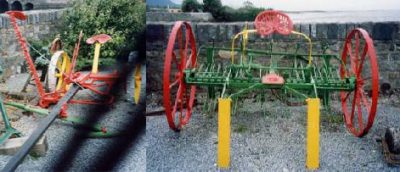
In the early part of this Century, agricultural practices in our area had not changed much from the 1850’s. Most farms were small, maybe 30 acres or less. Horses were the main form of power and there was very little equipment except maybe a plough and a harrow, a turnip sower and a corn sower. The small farmer might cut his hay with a scythe and when there was a lot of work to be done, a meitheal (group of workmen) was organised. The more up to date farmers would have had a horse drawn mowing machine for cutting their hay. Reapers and Binders were used for cutting corn from the 1950s onwards and when the sheaves were drawn in, there was a great day at the threshing. This was a great day on the farm and the children stayed at home from school to help. This might by the only time a tractor might appear on the farm in the whole year. However, the development of the combine harvester put an end to all this in the end of the 1960s.
Eventhough some farmers had Fordson tractors in the early part of the Century, tractors didn’t really become popular until Harry Ferguson developed his “Little Grey Fergie” . From then on tractors grew in popularity and with a whole range of implements to go with them, took most of the drudgery out of farming. Even though farms are much bigger now in the Rusheen area, a lot of them are operated by just one person only.
Another big change in our area came when Electricity was introduced in the 1950s. Oil lamps and candles were the only light people had until then. The tilly lamp was a great improvement on the old oil lamp. Electricity however changed all this and enabled farmers to increase the size of their herds immensely. It also meant that wells could be sunk and water piped directly into houses. It enabled the housewife to install many labour saving devices in their houses such as cookers, washing machines, etc.
During these times, to travel about people had to walk, cycle,or go by horse and cart. The introduction of the motor car changed all that especially in the country side. The first cars around the Rusheen area were Morris Minors or Anglias.
Entertainment in the Rusheen area was greatly different from what it is today. If a family was lucky, it might have a gramophone at home. There were no televisions, PlayStations or discos and for nightly entertainment, people went “scoraíorting” to each others houses, went to the platform dancing or to the cross roads for a chat.